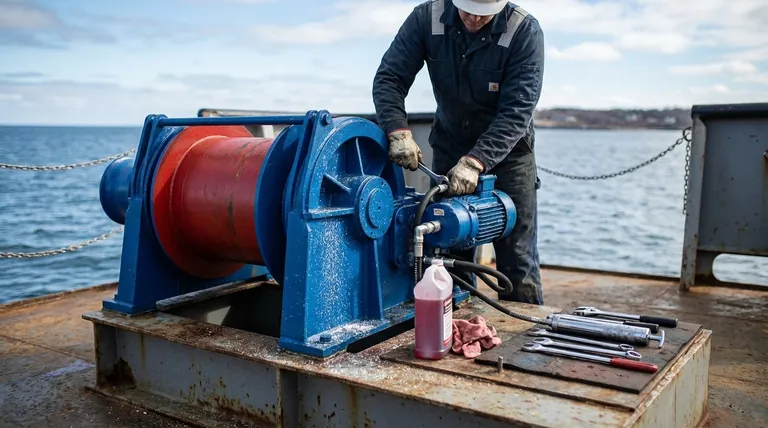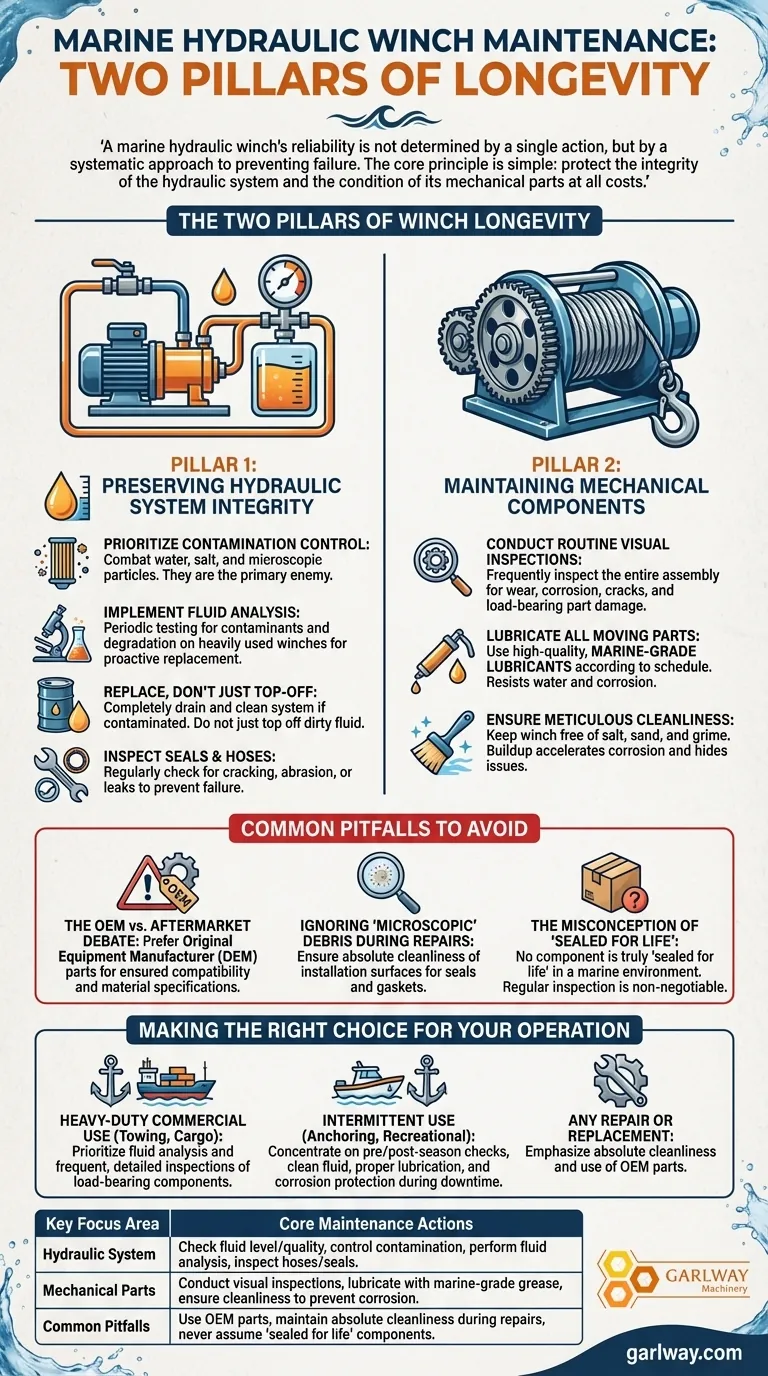The most effective maintenance for marine hydraulic winches centers on a disciplined routine of inspection, hydraulic fluid management, lubrication, and cleanliness. These practices work together to combat the primary causes of failure in a harsh marine environment: hydraulic system contamination and mechanical wear from corrosion and stress.
A marine hydraulic winch's reliability is not determined by a single action, but by a systematic approach to preventing failure. The core principle is simple: protect the integrity of the hydraulic system and the condition of its mechanical parts at all costs.

The Two Pillars of Winch Longevity
Effective maintenance can be broken down into two critical areas of focus: the hydraulic system that provides power and the mechanical components that bear the load.
Pillar 1: Preserving Hydraulic System Integrity
The hydraulic system is the winch's lifeblood. Its health dictates the machine's power and responsiveness.
Check Fluid Level and Quality Always ensure the hydraulic fluid is at the manufacturer's recommended level. Operating with fluid that is too low can cause pump cavitation and damage, while too-high levels can lead to leaks and overheating.
Prioritize Contamination Control Contamination is the number one enemy of any hydraulic system. Water, salt, and microscopic particles can degrade fluid, damage pumps, and clog valves.
Implement Fluid Analysis For heavily used or critical winches, periodic fluid analysis can identify contaminants and fluid degradation before they cause a catastrophic failure. This allows for proactive fluid replacement.
Replace, Don't Just Top-Off If fluid is found to be contaminated, it must be completely drained and replaced. Simply topping off a dirty system circulates the damaging particles, leading to accelerated wear. Always clean residual impurities from the system during a fluid change.
Inspect Seals and Hoses Regularly inspect all hydraulic hoses, fittings, and seals for signs of cracking, abrasion, or leaks. A compromised seal or hose is a common and preventable point of failure.
Pillar 2: Maintaining Mechanical Components
The winch's frame, drum, gears, and cables are constantly exposed to immense physical stress and corrosive elements.
Conduct Routine Visual Inspections Frequently inspect the entire winch assembly for visible signs of wear, corrosion, cracks, or other physical damage. Pay close attention to load-bearing parts and welds.
Lubricate All Moving Parts All gears, bearings, and other moving components must be lubricated according to the manufacturer's schedule. It is critical to use high-quality, marine-grade lubricants that resist water washout and prevent corrosion.
Ensure Meticulous Cleanliness Keep the winch clean and free of salt, sand, and other debris. A buildup of grime can accelerate corrosion, hide developing problems, and interfere with smooth operation.
Common Pitfalls to Avoid
Even with a plan, common mistakes can undermine your efforts and lead to premature failure.
The OEM vs. Aftermarket Debate
When replacing parts like seals or filters, always prefer Original Equipment Manufacturer (OEM) components. While they may cost more upfront, they guarantee perfect compatibility and material specifications designed for the system's pressures and fluids.
Ignoring "Microscopic" Debris During Repairs
After any disassembly or repair, all installation surfaces for seals and gaskets must be perfectly clean. A single grain of sand or a tiny metal filing can create a microscopic leak path, leading to persistent fluid loss and contamination ingress.
The Misconception of "Sealed for Life"
No component in a harsh marine environment is truly "sealed for life." Regular inspection is non-negotiable. Assume that water and contaminants are always trying to get in and act accordingly.
Making the Right Choice for Your Operation
Your maintenance schedule should adapt to the winch's role and operational demands.
- If your primary focus is heavy-duty commercial use (towing, cargo): Prioritize scheduled fluid analysis and more frequent, detailed inspections of all load-bearing components.
- If your primary focus is intermittent use (anchoring, recreational mooring): Concentrate on pre-season and post-season checks, ensuring fluid is clean and all parts are properly lubricated and protected from corrosion during downtime.
- If you are performing any repair or part replacement: Emphasize absolute cleanliness of all components and the use of OEM parts to ensure system integrity.
Ultimately, diligent and proactive maintenance is the only way to ensure your hydraulic winch delivers the power and reliability you depend on when it matters most.
Summary Table:
| Key Focus Area | Core Maintenance Actions |
|---|---|
| Hydraulic System | Check fluid level/quality, control contamination, perform fluid analysis, inspect hoses/seals. |
| Mechanical Parts | Conduct visual inspections, lubricate with marine-grade grease, ensure cleanliness to prevent corrosion. |
| Common Pitfalls | Use OEM parts, maintain absolute cleanliness during repairs, never assume 'sealed for life' components. |
Ensure your marine operations run smoothly with a winch built for reliability. The disciplined maintenance practices outlined are crucial for any hydraulic winch. For construction companies and contractors working in demanding environments, having the right equipment is the first step to minimizing downtime. GARLWAY specializes in durable construction machinery, including robust hydraulic winches, concrete mixers, and batching plants, designed to withstand harsh conditions.
Let our expertise in heavy-duty machinery be your advantage. Contact our team today to discuss your specific needs and discover how GARLWAY's solutions can enhance the reliability and efficiency of your projects.
Visual Guide

Related Products
- Electric 120V Boat Winch by Badlands
- Warn Winch Windlass Boat Trailer Winch
- Electric Hoist Winch Boat Anchor Windlass for Marine Applications
- Electric and Hydraulic Winch for Heavy Duty Applications
- Heavy Duty Electric Boat Winch Windlass Anchor
People Also Ask
- How do electric boat winches work? Unlock Effortless Launching & Retrieval
- What does a boat winch attach to? Secure Your Boat with the Right Mounting System
- How to pick a boat winch? Choose the Right Trailer or Anchor Winch for Your Boat
- How to choose a boat winch? A Guide to Selecting the Right Trailer or Anchor Winch
- What does a boat winch do? Effortlessly Load Your Boat and Haul Anchors



















